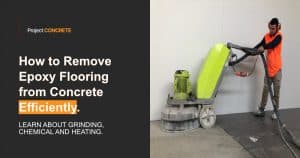
When it comes to how to remove epoxy flooring from concrete, knowing the right approach is key. This guide cuts straight to the chase when it comes to removing epoxy coatings, offering explicit steps for both mechanical and chemical removal methods, while highlighting the importance of safety. Avoid damage and tackle your project with confidence by following our comprehensive directions.

Understanding Epoxy Flooring and Its Removal
Epoxy flooring is a common floor option for both industrial and residential spaces.
It consists of two main components, namely Part A resin and Part B hardener, which together form a strong epoxy glue that adheres to concrete surfaces. When these two parts are mixed together, they create a durable, chemical-resistant surface, which is why epoxy is popular in high-traffic areas and for its ease of cleaning and maintenance.
However, there are challenges associated with epoxy flooring, especially when it comes to removal. Removing a epoxy coating from a concrete surface can be a complex and labour-intensive process. This difficulty arises due to the strong bond it forms with the concrete, necessitating the use of professional equipment and expertise. The removal process can involve mechanical methods such as grinding or blasting and sometimes chemical strippers to weaken the epoxy’s adhesion. This task can be time-consuming and requires careful planning to avoid damaging the underlying concrete.

Essential Safety Precautions
Ensure Adequate Ventilation
Proper ventilation is crucial during the epoxy removal process to prevent inhaling harmful fumes. Keeping doors and windows open for air circulation is advised, along with using solvents sparingly due to their fume-producing nature. In certain cases, mechanical grinding may be a safer alternative than chemical solvents. Adequate airflow is not just a safety measure, but also crucial for the quality of removal, preventing moisture build-up which could affect the bonding of the epoxy to the concrete.
Use Protective Gear
Safety gear is vital when removing epoxy. This includes non-slip footwear, eye protection (goggles or face shields), respiratory masks, acid-resistant gloves, and appropriate clothing. This protective equipment guards against skin irritation and eye damage from the epoxy resin and hardener and reduces the risk of inhaling harmful silica dust.
Chemical Use
Handling chemicals with care is essential. Avoid direct skin or eye contact with resin, hardeners, mixed epoxy, and sanding dust. In case of accidental contact, seek immediate medical attention. Ensure that chemicals are stored in well-ventilated containers and follow local regulations for disposal of hazardous waste.
For those considering the removal of epoxy flooring, these safety precautions are critical. Ensuring personal well-being and protecting the integrity of the concrete floor is paramount. Adhering to these guidelines will help maintain a safe environment for all involved and ensure the successful removal of the epoxy coating.
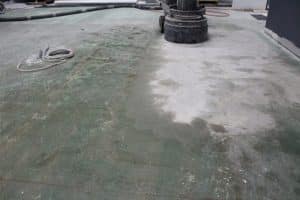
Mechanical Grinding
Removing epoxy flooring often involves mechanical grinding, a favoured method that employs specialized tools like floor grinders, sanding machines, and various types of diamonds and discs. This technique effectively breaks down the tough layers of hardened epoxy paint into finer particles, easing the removal process. However, the procedure can be physically taxing and requires specialized skills to execute correctly without damaging the surrounding surfaces.
For effective epoxy floor coating removal with this method, it’s essential to have the right attachments for the specific grinder model in use. Considerations such as the coating’s type and thickness are crucial in this process. Moreover, the involvement of hazardous materials like paint thinner in projects dealing with epoxy coatings should be carefully managed for your concrete floor.
The process typically involves methodically moving across each floor section in parallel runs, repeating until all targeted areas are thoroughly ground down. Despite its efficiency, improper use or mishandling of the grinding equipment can lead to potential damage to nearby delicate surfaces. Therefore, possessing sufficient knowledge and expertise is critical before removing epoxy paint.
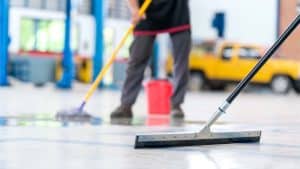
Chemical Solvent Method for Epoxy Flooring Removal
The chemical solvent approach offers an alternative method to remove epoxy flooring. This process involves selecting an appropriate solvent, applying it correctly, and conducting effective post-clean up. Below is a detailed guide on each step to ensure safe and efficient removal of epoxy flooring.
Choosing the Right Solvent
Selecting an effective solvent is key in this approach. Recommended solvents include isopropyl alcohol, denatured alcohol, acetone, and lacquer thinner.
For tougher stains and build up on concrete surfaces, solvents containing potassium hydroxide are effective. Allow these solvents ample time to penetrate and work on the epoxy. Environmentally friendly options like VOC-free cleaners (dibasic ester) or bio-based solvents (alcohols) are also effective in dissolving epoxy while being eco-conscious.
Ensure the chosen solvent is compatible with both the concrete surface and the epoxy to avoid any corrosive damage.
Application Techniques
Applying the solvent correctly is crucial for effective epoxy removal:
- Dip a soft cloth in acetone and gently rub the epoxy-coated areas to allow the solvent to soak into the material.
- Leave the solvent on the surface for at least 24 hours or as recommended by the product’s instructions.
- Gather necessary tools such as measuring jugs, tape, rags, cleaning agents, hand cleanser, booties, concrete grinder, mixers, and rollers.
- Careful application minimizes potential surface damage and ensures thorough removal of the epoxy.
Clean up and Safe Disposal
Once the epoxy has been loosened and removed, focus on clean up:
- Use household vinegar for a mild clean up approach, or opt for denatured alcohol and acetone for more thorough cleaning.
- Properly dispose of any cured epoxy waste as regular household waste.
- For liquid resin leftovers or epoxy mixed with solvents, follow local hazardous waste regulations for disposal, ensuring environmental safety and legal compliance.
The chemical solvent method, when executed with the right materials and techniques, provides an effective way to remove epoxy flooring. It’s crucial to adhere to safety precautions and environmental regulations throughout the process.
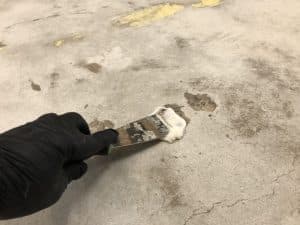
Scrape and Heat Technique
The scrape and heat technique offers a practical approach to removing epoxy flooring. This method combines the use of a scraping tool and applied heat to gradually loosen and remove the epoxy resin from the surface. Essential tools for this process include a scraping instrument, like a knife, and a heating device such as a heat gun.
Step-by-Step Guide for Scrape and Heat Technique
- Preparation: Begin by focusing on a small, manageable area. This method is particularly effective in smaller spaces where precise control is needed.
- Applying Heat: Use the heat gun to gently warm the epoxy resin. Aim for enough heat to cause visible bubbling or softening of the epoxy in the targeted area. Avoid overheating to prevent fire hazards or damage to the underlying surface.
- Scraping: As the epoxy begins to soften, use the scraping tool to chip away at the resin. This step should be done cautiously to avoid gouging the surface beneath the epoxy.
- Repetition: Multiple passes with the scraper and heat gun might be required to completely remove the epoxy. Continue the process, working slowly and methodically through the area.
- Safety in Tight Spaces: In confined areas, use caution to prevent accidental fires or burns. An easily-controlled spray bottle can be used to apply controlled amounts of water, reducing the risk of overheating and providing an additional safety measure.
- Cleanup: After the epoxy has been removed, clean the surface thoroughly to remove any residual material or debris.
The scrape and heat technique requires patience and attention to detail, but can effectively remove epoxy flooring without the need for harsh chemicals or extensive mechanical equipment. Safety should be a top priority throughout the process, especially when working with heat in confined spaces.
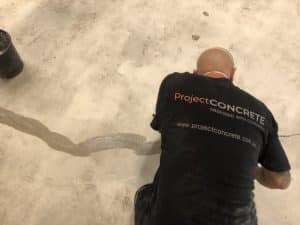
Repair and Reseal the Concrete Surface
After the removal of epoxy flooring, the concrete surface often requires repair and resealing to restore its condition and protect it from future damage. Here’s a step-by-step guide to effectively repair and seal your concrete surface:
- Preparing the Damaged Area:
- Inspect the concrete surface for any damage caused during the epoxy removal process.
- Clean the area thoroughly, removing any debris or dust. This ensures a smooth surface for repair.
- Applying Epoxy Patch:
- Use a high-quality epoxy patching compound suitable for concrete surfaces.
- Fill in cracks or holes, following the manufacturer’s instructions for mixing and application.
- Ensure the patch is applied evenly for a smooth finish.
- Sanding and Cleaning:
- Once the epoxy patch has dried, sand the area to create a level surface.
- Clean off any sanding residue to prepare for the new epoxy coating.
- Applying New Epoxy Coating:
- Choose a suitable epoxy coating for your specific needs, whether for residential floors or high-traffic areas like warehouses.
- Apply the new coat of epoxy evenly, following the product’s application guidelines.
- Curing and Sealing:
- Allow the new epoxy coating to cure completely, typically for about 7 days.
- After curing, apply an epoxy sealer for enhanced durability and protection.
- Choosing the Right Sealant:
- Opt for a durable epoxy sealer designed to withstand various environments.
- This type of sealant will provide long-lasting protection for your concrete surface, making it suitable for both residential and commercial settings.
- Be sure to allow 7 days for complete cure before applying sealant.
For concrete surfaces that have undergone epoxy removal, it’s advisable to use a reliable and sturdy sealant. An epoxy sealer is highly recommended for this purpose due to its durability and adaptability. It’s capable of withstanding diverse conditions, ranging from the everyday wear of residential flooring to the rigorous demands of high-traffic commercial areas like warehouses and food processing plants.
Adhering to these guidelines ensures that your concrete surface not only returns to its original condition but also gains enhanced, enduring protection. This is particularly important following the treatment involved in the removal process, which can affect the surface’s integrity. The application of an epoxy sealer after such procedures helps safeguard the concrete against potential damage, preserving the quality and longevity of the surface initially established by epoxy floor coating applications.
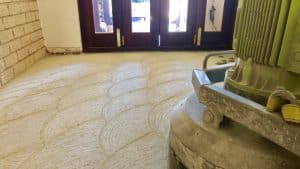
Professional Epoxy Flooring Removal Services
Dealing with the removal of epoxy flooring from concrete surfaces can be challenging and labour-intensive. Even with detailed instructions, larger or more complex projects often necessitate the expertise of professionals. This is where Project Concrete steps in – offering professional assistance that guarantees efficiency and safety in the removal process.
Why Choose Project Concrete?
- Expertise in Flooring Removal: Our team at Project Concrete is equipped with extensive knowledge and experience in both preparing and applying flooring. We understand the intricacies of the removal process, ensuring that your project is handled with the utmost care and professionalism.
- Cost-Effective Services: Our services are priced competitively, ranging from $20-$30 per square meter for thin layer removal to $40-$60 per square meter for thicker layers. While it may initially seem like an additional cost, investing in professional services from Project Concrete ensures a swift, safe, and effective completion of your project.
- Quality and Safety Assured: With Project Concrete, you can rest assured that your epoxy flooring removal will be conducted with the highest standards of quality and safety. Our skilled professionals are committed to delivering exceptional results that meet your satisfaction.
Ready to Transform Your Space?
Don’t let the challenge of epoxy flooring removal hinder the transformation of your space.
Contact Project Concrete today for expert assistance. Our team is ready to provide you with a hassle-free, safe, and efficient flooring removal service, tailored to your specific needs.
Let us help you restore your concrete surface to its original glory with ease and professionalism. Reach out to Project Concrete now for a seamless flooring removal experience.
Summary
Removing epoxy flooring from a concrete surface, while a complex and demanding task, can be effectively managed with the right approach and safety measures. The process can be tackled using various methods, each suited to different types of epoxy coatings and concrete surfaces. The chosen method should prioritize personal safety and the integrity of the concrete underneath. In cases where the project is large or intricate, seeking professional assistance may be advisable to ensure success.
Regardless of the method, it’s crucial to implement proper safety measures, including wearing protective gear and ensuring good ventilation, especially when working with chemical solvents or heat.
If you’re unsure about handling this process yourself, consider reaching our professional services at Project Concrete. Our expertise can guarantee a safe, efficient, and successful removal of epoxy flooring, preserving the quality of your concrete surface.
Frequently Asked Questions
Can epoxy be removed from concrete?
To remove epoxy from concrete, it is possible to use either grinding tools and safety gear or a suitable solvent with a blade. Both methods are effective in getting rid of unwanted material on the surface of concrete.
How do you remove hardened epoxy?
To remove hardened epoxy, utilize more potent solvents such as isopropyl alcohol, denatured alcohol, acetone or lacquer thinner. Exercise caution to avoid damaging the surface while gently scraping off the cured resin with a knife or similar tool. Take care not to touch any damp areas where solvent may have been applied before it has had time to evaporate on its own.
What is the best tool to remove epoxy flooring?
The optimal method for eliminating epoxy flooring is with a ride-on floor scraper. It’s advised to have skilled individuals operate this equipment. It should only be used by professionals in order to effectively remove the epoxy from the floor surface.
Are epoxy floors hard to remove?
Removing epoxy floors can be a challenging task and usually requires mechanical methods for the best results. While options like applying heat or using acetone may work for smaller areas or thinner coatings, they are not typically recommended as the main means of removal.
What is epoxy flooring made of?
Epoxy flooring is primarily made up of two main elements: Part A resin and Part B hardener, which work together to create a robust epoxy adhesive.
This type of flooring does not have a specific end date as it is durable and long-lasting. Its key components are the resin and hardener that form an effective epoxy glue when combined.
